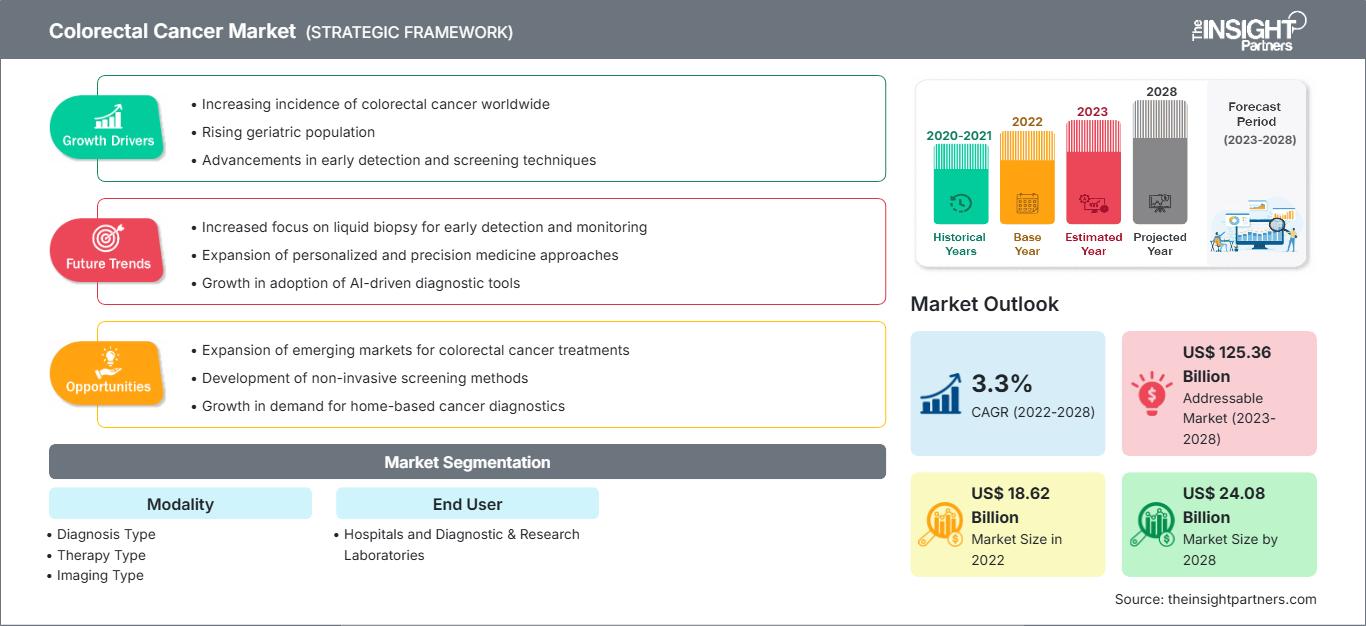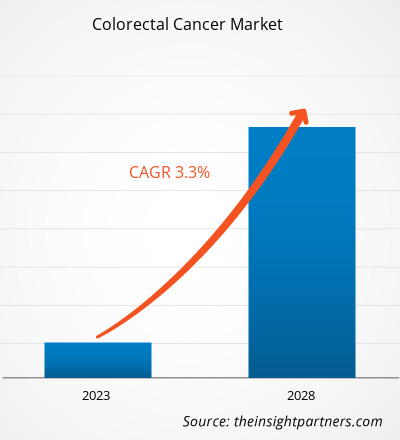The colorectal cancer market is expected to grow from US$ 18,619.3 million in 2022 to US$ 24,078.5 million by 2028; it is expected to grow at a CAGR of 3.3% from 2022 to 2028.
Factors such as the increasing prevalence of colorectal cancer, product launches, and benefits offered by generic drugs are driving the global colorectal cancer market growth. However, pricing pressure on drug manufacturers is hindering the market growth.
Colorectal cancer is a malignant tumor of the large intestine's inner wall. This is due to abnormal cell growth that can invade or spread to other body parts. Colorectal cancer is commonly caused by inflammatory bowel disease and genetic inheritance. Fatigue, diarrhea or constipation, shortness of breath, weakness, change in bowel habits, red or dark blood in stool, weight loss, abdominal pain, and bloating are a few common symptoms. Colorectal cancer is classified into four stages: stage 0, stage I-cancer in the inner layers of the colon, stage II-cancer spreads through the muscle wall of the colon, stage III-cancer spreads to lymph nodes, and stage IV-cancer spreads to other organs. Colorectal cancer can be treated with chemotherapy, radiotherapy, and surgery.
Customize This Report To Suit Your Requirement
You will get customization on any report - free of charge - including parts of this report, or country-level analysis, Excel Data pack, as well as avail great offers and discounts for start-ups & universities
Colorectal Cancer Market: Strategic Insights

-
Get Top Key Market Trends of this report.This FREE sample will include data analysis, ranging from market trends to estimates and forecasts.
North America is likely to dominate the colorectal cancer market during the forecast period owing to increasing incidences of colorectal cancer, better healthcare infrastructure, supportive government policies, a huge base of multinational companies, and high awareness among people about diagnostic testing and devices in healthcare. In addition, the US held the largest share of the North American market in 2022, and the country is expected to dominate the regional market during the forecast period. As per the American Cancer Society, colorectal cancer is the third most common cancer diagnosed in both men and women in the US, and ~104,270 new cases of colon cancer and 45,230 new cases of rectal cancer were reported in the country in 2021. The lifetime risk of getting diagnosed with colorectal cancer is ~1 in 22 for men, which accounts for ~5%. Similarly, for women, it is about 1 in 24, which accounts for ~4.5%. This rising number of cancer cases is augmenting the demand for colorectal cancer treatment and diagnostics across the country.
The global colorectal cancer market is segmented into modality, end user, and geography. By geography, the market is segmented into North America, Europe, Asia Pacific, the Middle East & Africa, and South & Central America. The global colorectal cancer market report offers insights and in-depth analysis of the market, emphasizing parameters such as market trends, technological advancements, market dynamics, and the competitive analysis of the globally leading market players.
Market Insights
Rise in Incidence of Colorectal Cancer
Colorectal cancer is one of the most commonly found and lethal cancers developed in individuals with the combined influence of genetic and environmental factors. According to the World Health Organization (WHO), colorectal cancer is the third most prevalent form of cancer, with ~1.93 million global cases in 2020, and an increase of ~70% in colorectal cancer cases worldwide is expected by 2030. Furthermore, according to the National Institute of Health, colorectal cancer (CRC) accounts for over 9% of all cancer incidences and is a major cause of morbidity and mortality worldwide in 2020. Furthermore, colorectal cancer mortality and incidence rates vary globally, and ~916,000 deaths in 2020 were due to colorectal cancer. It is the third most common cancer in men and the second most common cancer in women. The lifetime risk of developing colorectal cancer is about 1 in 23 for men and 1 in 25 for women. Therefore, colorectal cancer was identified as the third most common cancer and the second most death-causing cancer.
Colorectal cancer is increasingly affecting the populations in Asian countries. For instance, according to the International Agency for Research on Cancer & GLOBOCAN, the estimated incidence of colorectal cancer in Asia reported ~1,009,400 new cases in 2020. Japan, China, Malaysia, Singapore, Korea, and Turkey witnessed high prevalence rates compared to the other countries in Asia Pacific.
People with localized stage colorectal cancer have a 90% chance of surviving after five years. The 5-year survival rate is 71% if cancer spreads to neighboring tissues, organs, or regional lymph nodes. Surgery, immunotherapy, chemotherapy, radiation therapy, and targeted therapy are the most common treatment for colorectal cancer. Depending on the cancer stage, two or more of these treatment methods can be administered concurrently or sequentially.
Thus, the rising number of patients suffering from the disease has increased the demand for colorectal cancer solutions, thus driving the growth of the global colorectal cancer market.
Modality Insights
Based on modality, the global colorectal cancer market is segmented into diagnosis type, therapy type, and imaging type. In 2022, the diagnosis type segment holds the largest market share and is expected to register the highest CAGR during the forecast period. Moreover, the diagnosis type segment is further categorized into immunohistochemistry, stool test, flexible sigmoidoscopy, colonoscopy, CEA test, and others. The stool test segment is anticipated to register the highest CAGR in the market during the forecast period, owing to the increasing number of diagnostics tests done by patients.
Colorectal Cancer Market Regional InsightsThe regional trends and factors influencing the Colorectal Cancer Market throughout the forecast period have been thoroughly explained by the analysts at The Insight Partners. This section also discusses Colorectal Cancer Market segments and geography across North America, Europe, Asia Pacific, Middle East and Africa, and South and Central America.
Colorectal Cancer Market Report Scope
| Report Attribute | Details |
|---|---|
| Market size in 2022 | US$ 18.62 Billion |
| Market Size by 2028 | US$ 24.08 Billion |
| Global CAGR (2022 - 2028) | 3.3% |
| Historical Data | 2020-2021 |
| Forecast period | 2023-2028 |
| Segments Covered |
By Modality
|
| Regions and Countries Covered |
North America
|
| Market leaders and key company profiles |
|
Colorectal Cancer Market Players Density: Understanding Its Impact on Business Dynamics
The Colorectal Cancer Market is growing rapidly, driven by increasing end-user demand due to factors such as evolving consumer preferences, technological advancements, and greater awareness of the product's benefits. As demand rises, businesses are expanding their offerings, innovating to meet consumer needs, and capitalizing on emerging trends, which further fuels market growth.

- Get the Colorectal Cancer Market top key players overview
End User Insights
Based on end user, the global colorectal cancer market is bifurcated into hospitals and diagnostic & research laboratories. In 2022, the hospitals segment holds a larger market share, and is expected to register a higher CAGR in the market during the forecast period. Hospitals are the largest entities that have all the facilities. The hospital provides extensive healthcare and medical services to patients suffering from various diseases and disorders. Nowadays, hospitals give better services to their patients. Enormous patients are admitted for the procedure while several patients walk-in for the diagnostics. Among the admitted patients, most of them are already suffering from a few disorders. Thus, hospitals are contributing a significant market share to the global colorectal cancer market and are expected to continue the trend during the forecast period.
Several emergency and treatment centers need an investigation of the body's organs, tissues, and functions that can be done accurately with the help of magnetic resonance imaging, CT, and X-Ray. Most surgeries are being performed in hospitals, owing to continuous patient care and monitoring. As hospitals are primary healthcare centers for the people, it is likely to propel the growth of the end user segment over the forecast years. Therefore, owing to all the above-mentioned factors, the global colorectal cancer market for the hospital segment is likely to grow in the coming years.
Product launches and collaborations are highly adopted strategies by the global colorectal cancer market players to expand their global footprints and product portfolios. The players also focus on the partnership strategy to enlarge their clientele, allowing them to maintain their brand name globally. They aim to flourish their market shares with the development of innovative products. A few of the recent key market developments are listed below:
- In May 2022, Bruker launched an innovative 7 Tesla and 9.4 Tesla conduction-cooled Maxwell magnets for its market-leading preclinical magnetic resonance imaging (MRI) systems portfolio. Following the success of its BioSpec Maxwell 3 Tesla model, the new range of Maxwell 7 Tesla and 9.4 Tesla magnets eliminates the need for liquid Helium or Nitrogen refills while offering high-field sensitivity and resolution for advanced preclinical MRI and PET/MR research.
- In January 2022, Amgen and Generate Biomedicines entered a research collaboration agreement to discover and develop protein therapeutics for five clinical targets across multiple therapeutic areas and modalities. The collaboration will increase drug discovery efforts, generating novel protein sequences with optimal therapeutic properties.
F. Hoffmann-La Roche AG, Epigenomics AG, Novigenix SA, Abbott Laboratories, Amgen Inc., Volitionrx, EDP Biotech, Clinical Genomics Technologies Pvt Ltd, Bruker, and Quest Diagnostics Incorporated are offering products and services in the market.
Frequently Asked Questions
Which region is projected to be the fastest growing region in the global colorectal cancer market?
Which region accounts for major market share in 2022 in global colorectal cancer market?
What are the growth estimates for the colorectal cancer market till 2028?
Which segment is dominating the colorectal cancer market based on modality?
What is the estimated colorectal cancer market size of the market in 2022?
What will be the CAGR of the colorectal cancer market during the forecast period?
Who are the major players in colorectal cancer market across the globe?
What are the driving factors for the global colorectal cancer market across the world?
What is colorectal cancer?
- Historical Analysis (2 Years), Base Year, Forecast (7 Years) with CAGR
- PEST and SWOT Analysis
- Market Size Value / Volume - Global, Regional, Country
- Industry and Competitive Landscape
- Excel Dataset
Recent Reports
Related Reports
Testimonials
Reason to Buy
- Informed Decision-Making
- Understanding Market Dynamics
- Competitive Analysis
- Identifying Emerging Markets
- Customer Insights
- Market Forecasts
- Risk Mitigation
- Boosting Operational Efficiency
- Strategic Planning
- Investment Justification
- Tracking Industry Innovations
- Aligning with Regulatory Trends





















 Get Free Sample For
Get Free Sample For